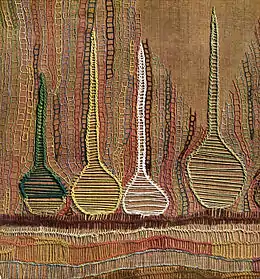Mariska Karasz
Mariska Karasz (1898 in Budapest, Hungary – August 27, 1960 in Danbury, Connecticut) was an American fashion designer, author, and textile artist. She had a passion for fashion design and created colorful, patterned garments largely inspired by the folk art of her native country. Her abstract wall hangings mixing fibers such as silk, cotton, wool, and hemp with horsehair and wood garnered her extensive national, and even international, attention. Critics repeatedly praised her for her skillful and unusual use of color, her creative combinations of materials, and her inspiring efforts to promote a modern approach to embroidery.[1]
Mariska Karasz | |
|---|---|
 | |
| Born | 1898 Budapest, Hungary |
| Died | August 27, 1960 (aged 61–62) Danbury, Connecticut, United States |
| Nationality | Hungarian-American |
| Known for | Fashion design, Textile Art, Writing |
| Spouse(s) | Donald Peterson |
Biography

Karasz learned to sew as a young girl in Hungary. She immigrated to New York City in 1914 at the age of sixteen. Karasz was the younger sister of industrial designer and New Yorker cover artist Ilonka Karasz. She taught herself embroidery, utilizing her family, animals, and the natural world surrounding her studio in Brewster, New York, as subject matter. As her talent developed, her pieces became increasingly abstract and refined.[2]
Mariska soon established a successful career as a fashion designer. Her foreign background and new American identity defined her custom clothing for women in the 1920s, which combined Hungarian folk elements with a modern American style.
In the early 1930s, after her marriage to Donald Peterson and the births of her two daughters, Solveig and Rosamond, Karasz began designing modern children's clothing, which was admired by parents, scholars, and critics for its practicality and originality.[3] Her career in fashion ended in the early 1940s, following a studio fire and the entry of the United States into World War II.
Mariska Karasz died in 1960, aged 62 years.[4]
Artistic career
In 1947, during the rise of American studio craft and abstract expressionism, Karasz began creating embroidered wall hangings. She exhibited her work in museums and galleries across the county, in over 50 solo shows during the 1950s.[2]
She also authored the book Adventures in Stitches in 1949 (republished in an expanded version in 1959), an influential book on creative needlework, and served as guest needlework editor for House Beautiful from 1952-1953.
The first retrospective of her work took place at the Georgia Museum of Art from January 20 to April 15, 2007. In 2010 her work was included in the exhibition "Textiles Recycled/Reimagined" at the Baltimore Museum of Art.[5]
Publications
- Karasz, Mariska (1943). See and Sew: A picture book of sewing (First ed.). New York: J.B. Lippincott Company.
- Karasz, Mariska (1946). Design and Sew (First ed.). United States: J.B. Lippincott Company.
- Karasz, Mariska (1949). Adventures in Stitches : a new art of embroidery (First ed.). New York: Funk & Wagnalls Co.
- Callahan, Ashley (2007). Modern Threads: Fashion and Art by Mariska Karasz. Athens, Georgia: Georgia Museum of Art. ISBN 9780915977611.
References
- Callahan, Ashley (2015). "Mariska Karasz's Creative Embroidery". The Journal of Modern Craft. 8 (2): 115–124. doi:10.1080/17496772.2015.1054698.
- https://craftcouncil.org/post/mariska-karaszs-adventures-stitchery American Craft Council
- Karasz, Mariska (1952). How to Make Growing Clothes for your Baby. New York: Pelligrini & Cudahy. OCLC 1835410.
- "Mariska Kavasz is Dead at 62; Needlework Artist and Author" New York Times (August 28, 1960): 83.
- Textiles Recycled/Reimagined at the Baltimore Museum of Art
- Callahan, Ashley: Modern Threads: Fashion and Art by Mariska Karasz. Athens, GA: Georgia Museum of Art, 2007.
- Biography at the Smithsonian American Art Museum, retrieved 28 June 2007
- Tartsinis, Ann Marguerite (2013). An American Style: Global Sources for New York Textile and Fashion Design, 1915-1928. New York: Yale University Press / Bard Graduate Center. ISBN 978-0-300-19943-7.
External links
| Wikimedia Commons has media related to Mariska Karasz. |